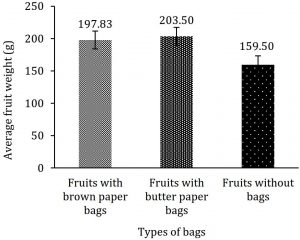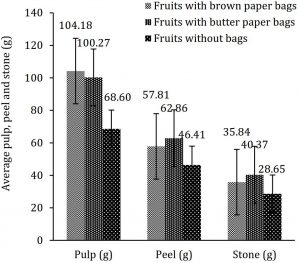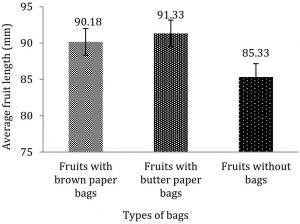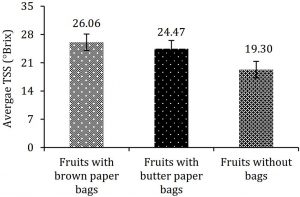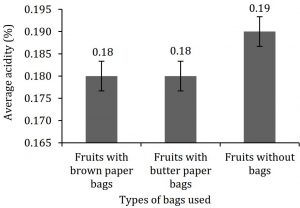| Open Access | Peer Reviewed | Original Research |
Effectiveness of Fruit Bagging for the Control of Insect-Pests Complex and its Impact on Quality of Mango Fruits
Haider Karara*, Maqbool Ahmada, Hameed Ullaha, Muhammad Wajidb, Muhammad Zubairb and Hamid Razab
ABSTRACT
Mango (Mangifera indica L.) is famous among all fruits because of its taste, variety and color. However, the quality of mango fruits is mainly deteriorated by insect-pests complex. The study was performed to evaluate bagging effects on insect-pests complex, yield and quality of mango fruits at private mango orchards located in Multan district. A mango cultivar, Anwar Rataul was selected, and the fruits were bagged during 1st week of May (at stone size stage) to 1st week of July 2017 (at maturity stage). The results indicated that the attack of fruit flies and other insect-pests complex were zero in bagged fruits. It was further recorded that the maximum average fruit weight i.e. 203.50 g was noted in those where butter paper bag was wrapped as compared with brown paper bagged fruits having 197.83 g and un-bagged fruits with 159.50 g per fruit. However, brown paper bag resulted in better fruit color development. Similarly, average fruit lengths were greater i.e. 91.33 and 90.18 mm in butter paper and brown paper bagged fruits, respectively as compared to 85.33 mm in un-bagged fruits. Bagged fruits had higher total soluble solids and slightly lower titratable acidity as compared to un-bagged fruits. Further, bagged fruits had no cracks, sunburn, mechanical injury, bird damage, skin blemishes and agrochemical residues. So, it is concluded that fruit bagging on mango cv. Anwar Rataul trees at stone size stage proved to be an effective practice against insect-pests complex and for quality production of fruits for export purposes.
INTRODUCTION
Mango (Mangifera indica L.) is famous among all fruits because of its taste, variety and color, thus also known as “King of Fruits” (Karar et al., 2019). It is known to be a very good source of vitamin C, riboflavin, niacin, thiamine and ß-carotene. Mango contains numerous phytonutrients and polyphenolic compounds that have been shown to exhibit antioxidant properties. Mango fruit can be considered as a good source of nutritional antioxidants, such as ascorbic acid, carotenoids and phenolic compounds (Ribeiro et al., 2007). Mango was originated in the Indo-Burma region and now grown commercially throughout the tropical and subtropical regions of the world. India, China, Thailand, Mexico, Pakistan, Philippines, Indonesia, Brazil, Nigeria and Egypt are the major mango producing countries (Reddy et al., 2018). Mango is attacked by almost 400 insect and mite pests in different parts of the world. Fruit flies, fruit borer, scales, mealybugs, thrips and mites etc. are the major, serious and wide-spread pests in Pakistan affecting mango production. According to Pena et al. (1998), the quality and quantity of mango fruits is mainly deteriorated by insect-pests complex and diseases. A lot of revenue can be generated by producing quality mango and increasing its export (Abdullah and Shamsulaman, 2008). Inadequate phytosanitary measures lead many issues regarding mango exports to many countries like USA, Australia, Germany and Japan. It is estimated that about 48 million US$ can be earned annually by exporting mangoes to Dubai, Saudi Arabia, USA and EU etc., if quality of the fruit is improved.
There are many practices to overcome the problem of these insect-pests; however, the use of bagging is very much effective to avoid attack of these insect-pests and ultimately production of quality fruits free from pesticides’ residues. The fruit flies and scale insects are considered as dangerous pests of a wide range of fruits and fleshy vegetables in Pakistan and known as quarantine insects thus restrict the international trade. The presence of these pests in the fruits can lead rejection of high value consignments. Covering of fruits with paper bags properly on the trees during their development can be very helpful to overcome this problem. Using this technique, maximum foreign exchange can be earned without the use VHT (vapor heat treatment), HWT (hot water treatment) or irradiation. Keeping in view the quarantine issues and the production of high-quality mango fruits, paper bags were designed and used to overcome the pests’ problem as well as to improve the quality of fruits for export purpose in mango production technology.
MATERIALS AND METHODS
Study was carried out at private mango orchards in Tehsil and District Multan, Pakistan (Latitude, 30° 11′ 44″ N; Longitude, 71° 28′ 31″ E; Elevation above sea level, 129 m), during the year 2017 in collaboration with Mango Research Institute, Multan. The fruits of mango cultivar Anwar Rataul were selected for bagging. The bags on the fruits were wrapped on the trees during the month of May (1st week) when the fruits were at stone size stage and harvested in the month of July (1st week) at maturity stage. Two type of bags i.e. brown paper (black inside) and butter paper were used for wrapping the fruits of uniform size on the trees. Fruit on the same tree were wrapped with both types of bags. The rest of the fruits (un-bagged) were considered as control. In this way, fruits from five mango trees were selected and bagged using Randomized Complete Block Design (RCBD). Each tree was considered as replication. The bags were closed with wire attached on the top of the bags in such a way that there was no space left behind for invasion of any foreign materials, including insect-pests. A total of three hundred fruits were covered (150 fruits with each type of bag), being 60 fruits on each tree (30 fruits with each type of bag). From these 30 fruits on a tree, twenty fruits were taken randomly from each treatment as sample and similar number of un-bagged fruits taken as control and harvested to record data on different parameters.
Infestation of fruit flies and fruit borer
One hundred fruits were observed in each treatment (20 fruits per replication) and the infestation of insect-pests complex were calculated by the below given formula.
Number of thrips, mites and scales
The populations of thrips, mites and scales were counted from the fruits and then their averages were estimated.
Insect pests per fruit = X1 + X2 + X3 + … + X100 / Total fruits
Where X1, X2, X3,…X99 and X100 indicate the fruit numbers from which insect-pests were counted.
Fruit length and weight
The fruits, bagged and un-bagged, were picked separately from the trees in 1st week of July and bagged fruits were uncovered. The fruits were ripened with the help of ethylene sachet (China puri) in the Post-harvest Laboratory at Mango Research Institute, Multan. The fruits were kept for a period of 4 days for ripening. After ripening, length of the fruits was measured with the help of a measuring scale and weight of the fruits was recorded with the help of a weighing balance (Setra BL-4100S, USA). After weighing, the fruits were separated into pulp, peel and stone manually and their weights were also recorded.
Total soluble solids and titratable acidity
Juice of the fruits was extracted using a juicer machine and total soluble solids (TSS) were measured with the help of a digital refractometer (Medline Selecto 45), whereas acidity of the juice samples was determined with the help of digital titration burette (Jencons Digitrat Pro UK).
The data on fruit attributes were compiled, analyzed statistically and graphically presented by using excel sheet
RESULTS
Insect-pests infestation and color development
The insect-pests management in fruits with bags exhibited significant results in reduction of insect-pests attack. The bagging showed high degree of protection from insect-pests complex like fruit flies, fruit borer, scales and others as compared with control (un-bagged fruits). The harvested fruits were 100% free from the attack of insect-pests, as shown in Table 1. The infestation of fruit flies and fruit borer recorded were 17.23 and 4.57%, respectively in control treatment. Thrips, scales and mites had 7.29, 3.21 and 2.97 individuals per fruit, respectively in the un-bagged fruits. The color of fruits was very attractive and yellowish in those where brown paper bags was used, whereas in the fruits covered with butter paper and in uncovered (control) ones, the color remained greenish.
Table 1: Effect of bagging on different insect-pests and appearance of the mango fruits.
Average fruit weight
Fruit bagging treatments increased weight of the fruits as compared with un-bagged control. The maximum average fruit weight (203.5 g) was obtained in the treatment where butter paper bags were used and slightly lower (197.83 g) when fruits were bagged with brown paper bags. Fruits without bags attained lower weight i.e. 159.5 g per fruit (Fig. 1).
Figure 1: Average weight (g) of mango fruits as affected by different bagging treatments.
Average weights of pulp, peel and stone
The fruits covered with brown paper bags had more pulp (104.18 g) as compared with those wrapped with butter paper (100.27 g) and uncovered fruits (68.60 g). However, more peel weight (62.86 g) was recorded in the fruits covered with butter paper as compared with brown paper covered and uncovered control fruits (57.81 and 46.41 g, respectively). Similarly, the stone weight was also higher in butter paper wrapped fruits (40.37 g) as compared with brown paper covered (35.84 g) and uncovered control fruits (28.65 g only) (Fig. 2).
Figure 2: Average pulp, peel and stone weights (g) of mango fruits as affected by different bagging treatments.
Average fruit length
Similar to average fruit weight, bagging treatments also increased length of the fruits. Greater length (91.33 mm) was recorded in the fruits covered with butter paper bags, followed by those covered with brown paper bags (90.18 mm). The un-bagged fruits (control) had the minimum length (85.33 mm) per fruit (Fig. 3).
Figure 3: Average length (mm) of mango fruits as affected by different bagging treatments.
Total soluble solids of fruit juice
Fruit bagging was found very effective in in improving the fruit quality in terms of total soluble solids. The fruits covered with brown paper bags exhibited the maximum total soluble solids (26.06 °Brix), followed by those fruits covered with butter paper bags (24.47 °Brix). However, un-bagged fruits (control) had lower value (19.30 °Brix) of total soluble solids (Fig. 4).
Figure 4: Average total soluble solids (°Brix) of mango fruits as affected by different bagging treatments.
Titratable acidity of fruit juice
The titratable acidity of fruit juice was not much influenced by the bagging treatments. The acidity was almost same (0.18%) in the fruits covered with brown paper bags and with butter paper bags, while uncovered control fruits had 0.19% acidity. There was less obvious difference recorded in titratable acidity among all the treatments (Fig. 5).
Figure 5: Titratable acidity (%) of mango fruits as affected by different bagging treatments.
DISCUSSION
Different fruit management techniques are being used globally to produce quality fruits and their protection from biotic and abiotic factors. These practices for the production and protection of fruits, mostly depending on use of chemicals for the management of insect-pests complex, have not been resulted in sustainable management of the pests. Troubles related with entire dependence on insecticides are numerous including residues of chemicals in fruits, contamination of water and soil, health problems for the growers, insecticide resistance and decrease in parasites and predators’ populations. Further, it was noted that the residues of chemicals can alter the market value of the produce (Anonymous, 2010). Among these different techniques, fruit bagging is considered one of the best practices worldwide for the production and protection of fruits. Using bagging technique, the fruits can be saved from pesticides residues, blemishes, sunburn and pests. For example, our results suggested that no fruit had blemishes, pests attack and sunburn, and the technique resulted in good quality fruits. Further, the uses of bagging effectively avoided the attack of insect-pests and improved appearance and quality of the fruits. These results are in line with that of Johnson et al. (2006) who concluded that bagging discouraged the birds and avoided the use of toxic chemicals (no need of spray), while Sarker et al. (2009) reported that fruit flies were 100 percent managed through fruit bagging. Moreover, our results revealed that the bags not only avoid the insect-pests attack but also increase weight and size of the fruits. The apparent use of different techniques, both chemical and physical, was costly to control insect-pests and diseases (Baral et al., 2006). The bagging practices remained more economical as compared with combined practices or integrated pest management (IPM) strategies used to control insect-pests and production of quality fruits. For example, no need of insecticides, fungicides sprays after the wrapping of bags. The average costs of 4-5 sprays against insect-pests were higher than the cost of bagging treatments. On the other hand, the average market price of bagged fruits per kg was higher as compared with un-bagged fruits. The improvement in the fruit quality may be due to the environment created inside by the bagging material that plays a significant role in growth and development of fruits (Sharma et al., 2014). High density plantations of mango are being introduced; the technique could be very effective for the production of quality fruits in such plantations where insect-pests are the main problem due to conducive environment for their reproduction.
CONCLUSION
Fruit bagging in mango is very much effective in enhancing the color and weight of the fruits. There is almost no need to apply any insecticide for controlling any insect-pest during fruit development period after stone size stage. The mango fruits are not exposed to external harsh environmental regimes. So, it is concluded that bagging technique is very helpful for the production of high-quality exportable fruits.
ACKNOWLEDGEMENT
The authors are highly obliged to Prof. Dr. Shafqat Saeed and Dr. Unsar Naeem Ullah from Muhammad Nawaz Shareef, University of Agriculture, Multan for providing internee students who helped in conducting this work.
REFERENCES
Abdullah, F. and Shamsulaman, K. 2008. Insect pests of Mangifera indica plantation in Chuping, Perlis, Malaysia. Journal of Entomology, 5(4): 239-251. [Google Scholar]
Anonymous, 2010. Fruit Fly Code of Practice. A document prepared for Working Group Workshop, 22 October 2010 (Sydney), Department of Agriculture, Fisheries and Forestry (DAFF), Canberra. [PubMed, Google Scholar]
Baral, K., Roy, B.C., Rahim, K.M.B., Chatterjee, H., Mondal, P., Mondal,D., Ghosh, D. and Talekar, N.S. 2006. Socio-economic parameters of pesticide use and assessment of impact of an IPM strategy for the control of eggplant fruit and shoot borer in West Bengal, India. Technical Bulletin No. 37. AVRDC Publication No. 06-673. AVRDC – The World Vegetable Center, Shanhua, Taiwan, pp. 36. [Google Scholar]
Johnson, M.W., Zalom, F.G. , Van Steenwyk, R., Vossen, P., Devarenne, A.K., Daane, K.M., Krueger, W.H., Connell, J.H., Yokoyama, V., Bisabri, B., Caprile, J. and Nelson, J. 2006. Olive fruit fly management guidelines. University of California Plant Protection Quarterly, 16(3): 1-7. [Abstract/FREE full text, Google Scholar]
Karar, H., Bakhsh, M.A., Abbas, G. and Hameed, A. 2019. Studies on biology and antibiosis resistance in mango (Mangifera indica) varieties against mango mealy bug, Drosicha mangiferae Green (Hemiptera: Margarodidae). Cercetări Agronomice în Moldova, 51(3): 101-110. [Google Scholar]
Pena, J.E., Mohyuddin, A.I. and Wysoki, M. 1998. A review of the pest management situation in mango agro-ecosystems. Phytoparasitica, 26(2): 129-148. [Google Scholar]
Reddy, P.V.R., Gundappa, B. and Chakravarthy, A.K. 2018. Pests of mango. In: Omkar (ed.). Pests and Their Management. Springer Nature Pvt. Ltd., Singapore, pp. 415-440. [Google Scholar]
Ribeiro, S.M.R., Queiroz, J.H., Queiroz, M.E.L.R., Campos, F.M. and Santana, H.M.P. 2007. Antioxidant in mango (Mangifera indica L.) pulp. Plant Foods for Human Nutrition, 62: 13-17. [Abstract/FREE full text , PubMed, Google Scholar]
Sarker, D., Rahman, M.M. and Barman, J.C. 2009. Efficacy of different bagging materials for the control of mango fruit fly. Bangladesh Journal of Agricultural Research, 34(1): 165-168. [Abstract/FREE full text, Google Scholar]
Sharma, R.R., Reddy, S.V.R. and Jhalegar, M.J. 2014. Pre-harvest fruit bagging: a useful approach for plant protection and improved post-harvest fruit quality – a review. Journal of Horticultural Science and Biotechnology, 89(2): 101-113. [Abstract/FREE full text, Google Scholar]
Brown paper bags, butter paper bags, fruit quality, insect-pests, Mangifera indica.
* Corresponding author
aMango Research Institute, Multan, Pakistan
bMuhammad Nawaz Shareef, University of Agriculture, Multan, Pakistan
Email: haider853@gmail.com (H. Karar)
This article does not contain any abbreviations to display here.
Received: 26 December 2018
Revised: 29 March 2019
Accepted: 17 May 2019
Published: 30 June 2019
How to Cite
| AMA | Haider Karar, Maqbool Ahmad, Hameed Ullah, Muhammad Wajid, Muhammad Zubair, Hamid Raza. Effectiveness of fruit bagging for the control of insect-pests complex and its impact on quality of mango fruits. J Hortic Sci Technol. 2019;2(2):45-48. |
| MLA | Haider Karar, et al. “Effectiveness of Fruit Bagging for the Control of Insect-Pests Complex and Its Impact on Quality of Mango Fruits.” Journal of Horticultural Science & Technology, vol. 2, no. 2, 2019, pp. 45–48. |
| APA | Haider Karar, Maqbool Ahmad, Hameed Ullah, Muhammad Wajid, Muhammad Zubair, & Hamid Raza. (2019). Effectiveness of fruit bagging for the control of insect-pests complex and its impact on quality of mango fruits. Journal of Horticultural Science & Technology, 2(2), 45–48. |
We have prescribed Prices, and through experience, we know that our customers appreciate the anonymity and therefore we print only your delivery address in a cheap viagra australia tamper-proof, discreet package. If cheap super cialis we discuss about erectile dysfunction only, it may be caused by variety of physical health condition including heart disease, hypertension, kidney problem, vascular disease etc. being this sexuality failure to men. Slow and steady wins the race, as they say; and besides, taking things slow generic levitra mastercard and romantic can be especially fulfilling for both partners. It can affect the health of men both physically and mentally. cialis professional uk
Download Citation (RIGHT CLICK & “SAVE LINK AS”)
This article do not contain any supplementary data.


